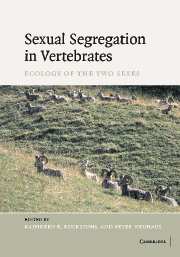Book contents
- Frontmatter
- Contents
- List of contributors
- Preface
- Part I Overview
- Part II Concepts and methodology
- Part III Foraging ecology
- Part IV Predator avoidance and reproductive strategies
- Part V Sex-related activities and social factors
- Part VI Sexual differences in ecology: comparisons within different taxa
- 13 Ecological divergence between the sexes in reptiles
- 14 Sexual segregation in Australian marsupials
- 15 Social systems and ecology of bats
- 16 Sociality and ecology of the odontocetes
- 17 Sexual segregation in non-human primates
- Part VII Implications for conservation
- Part VIII Outlook
- References
- Index
17 - Sexual segregation in non-human primates
Published online by Cambridge University Press: 04 September 2009
- Frontmatter
- Contents
- List of contributors
- Preface
- Part I Overview
- Part II Concepts and methodology
- Part III Foraging ecology
- Part IV Predator avoidance and reproductive strategies
- Part V Sex-related activities and social factors
- Part VI Sexual differences in ecology: comparisons within different taxa
- 13 Ecological divergence between the sexes in reptiles
- 14 Sexual segregation in Australian marsupials
- 15 Social systems and ecology of bats
- 16 Sociality and ecology of the odontocetes
- 17 Sexual segregation in non-human primates
- Part VII Implications for conservation
- Part VIII Outlook
- References
- Index
Summary
OVERVIEW
Sexual segregation is fairly common in non-human primates, usually in the form of social segregation (Box 17.1). Spider monkeys (Ateles spp.) and chimpanzees (Pan troglodytes) have fission-fusion social systems in which individuals form temporary subgroups (parties) within socially bounded communities; social segregation is not complete, but single-sex parties are common, and males are more gregarious than females and associate predominantly with each other. Some nocturnal lemurs (e.g. grey mouse lemurs, Microcebus murinus: Radespiel et al., 2001a, b) and bushbabies (Galago spp., Galagoides spp., Otolemur spp.) forage solitarily, but form sleeping associations that consist mostly of females. Macaques (Macaca spp.) form cohesive mixed-sex groups, but maturing males in some species spend time alone or in peripheral all-male groups before joining mixed-sex groups. Habitat segregation is rare, although males may use larger home ranges than females (e.g. orangutans, Pongo pygmaeus: Singleton & van Schaik, 2001; chimpanzees: Hasegawa, 1990) or expand their ranges during mating seasons (e.g. grey mouse lemurs: Eberle & Kappeler, 2002).
However, most diurnal primates, even those that breed seasonally, form stable, cohesive groups in which males and females associate permanently. Even when some males are socially peripheral (e.g. squirrel monkeys, Saimiri spp.; see later), females associate permanently with others. Stable female groups without permanently associated males are known only in mandrills (Mandrillus sphinx; Abernethy et al., 2002).
- Type
- Chapter
- Information
- Sexual Segregation in Vertebrates , pp. 327 - 348Publisher: Cambridge University PressPrint publication year: 2006



